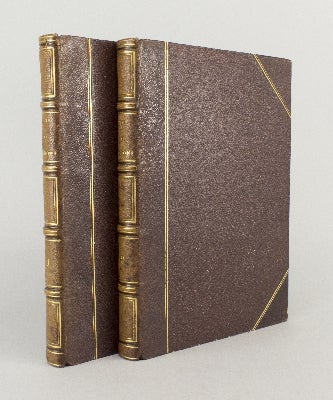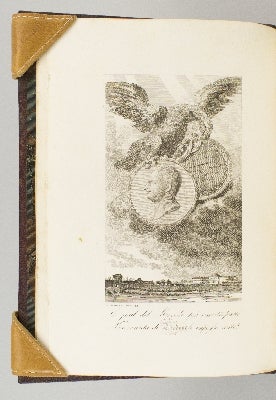VITA DEL CAVALIERE GIAMBATTISTA BODONI. TIPOGRAFO ITALIANO E CATALOGO CHRONOLOGICO DELLE SUE EDIZIONI.
(Parma: Dalla Stamperia Ducale, 1816). 248 x 159 mm. (9 3/4 x 6 1/4"). With the list of subscribers in volume I. Two volumes. FIRST EDITION.
Contemporary burgundy roan over matching buckram, raised bands, spines with gilt-ruled compartments, gilt titling, marbled endpapers, top edges gilt. Both volumes with engraved frontispiece, that in volume I featuring a medallion portrait of Bodoni and that in volume II depicting an angel beside a printing press; original tissue guards. With laid-in 19th century manuscript bibliographical note in French. Brooks 1170; Bigmore and Wyman I, 69; Birrell & Garnett 195. ◆Spines sunned to light brown and a little spotted, short crack to head of one joint, extremities a bit rubbed, boards lightly chafed, but the binding entirely sound, and A VERY FINE COPY INTERNALLY--especially clean, smooth, and bright, with extremely wide margins.
This classic biography of the enormously influential Italian printer has all of the production values he held dear: fine paper, generous margins, restrained composition, and, of course, beautiful typography. It also includes the first catalogue raisonné of his publications, described by Birrell & Garnett as "indispensable for the study of his work." The son of a printer, Bodoni (1740-1813) began his career in 1758, at the Roman press of the Vatican's missionary office. Working as a compositor, he distinguished himself with his gift for Middle Eastern languages, and eventually began cutting his own punches. After eight years he decided to leave Rome, hoping to travel to England to train with John Baskerville, whose clear types and unadorned composition he much admired. Illness unfortunately kept him in Italy, thwarting the possible meeting of two printing geniuses. When the Duke of Parma established his royal press in 1768, Bodoni was tapped to head it, and he soon established a reputation for printing excellence, becoming the principal European rival of Didot. By 1790, he was receiving offers to head presses in Rome and other cities, and in order to keep him in Parma, the duke allowed him to open his own private press, where he began to print the Greek and Roman classics that have been sought after by collectors down to the present day. Bodoni created more typefaces than any other typographer before or since--an 1840 inventory of his type counted 25,491 punches and 50,283 matrices--and his type cutting is beautifully displayed in the posthumously published masterwork, "Manuale Tipografico." He is one of a handful of 18th century printers whose work continues to influence typography and design: the "Bodoni" font has been popular since 1910, continuing into the digital era. (ST12764)
Price: $1,950.00


